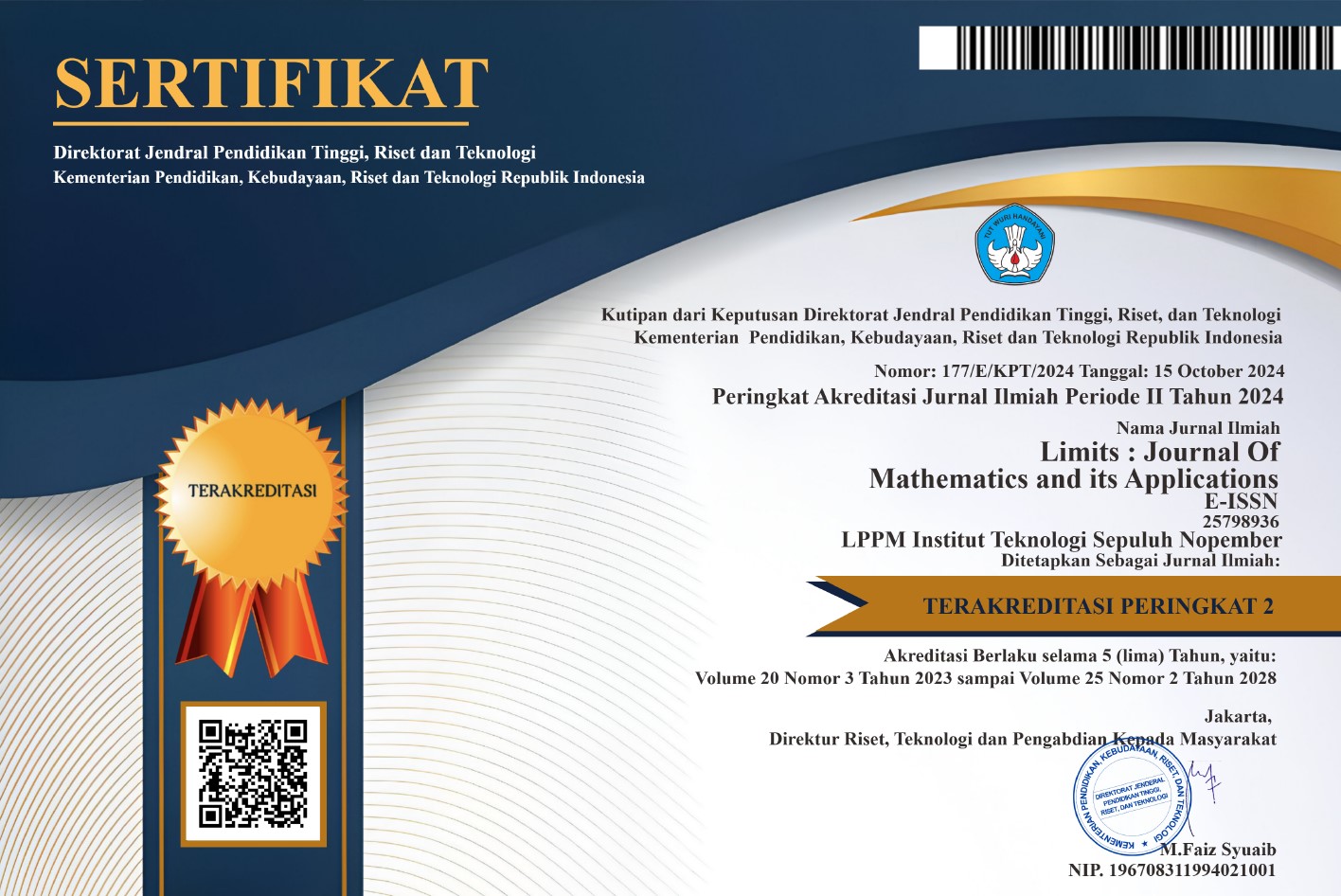Pengaruh Suplementasi Vitamin D dan BMI terhadap LVEF dengan Pendekatan Generalized Additive Models Longitudinal
DOI:
https://doi.org/10.12962/limits.v22i1.3378Keywords:
Generalized Additive Models, LongitudinalAbstract
Cardiovascular diseases (CVD) are the leading cause of global mortality, with Left Ventricular Ejection Fraction (LVEF) being a key indicator of heart function. This study explores the impact of vitamin D supplementation and Body Mass Index (BMI) on LVEF using Generalized Additive Models (GAM) in longitudinal data from 47 elderly patients with hypovitaminosis D undergoing orthopedic surgery. LVEF was measured before surgery and at 1, 3, and 6 months post-intervention. GAM was employed to capture nonlinear relationships between variables with working correlation structures such as Independence, Exchangeable, Unstructured, and Autoregressive-1 (AR-1). The findings revealed a significant increase in vitamin D levels and LVEF following supplementation, while BMI remained relatively stable throughout the observation period. The best GAM model with AR-1 correlation structure achieved the lowest Quasi Information Criterion (QIC) score of 443.47, indicating a complex relationship between vitamin D and LVEF and a linear relationship between BMI and LVEF. Vitamin D demonstrated a significant nonlinear effect on LVEF improvement, whereas a 1-point increase in BMI raised LVEF by 0.291%. This study underscores the importance of vitamin D supplementation in enhancing heart function among elderly patients with hypovitaminosis D, supporting the development of evidence-based health policies
Downloads
References
W. H. Organization, “Cardiovascular Diseases (CVDs),” 2021. https://www.who.int/en/news-room/fact-sheets/detail/cardiovascular-diseases-(cvds).2.
E. D. Folland, A. F. Parisi, P. F. Moynihan, D. R. Jones, C. L. Feldman, and D. E. Tow, “Assessment of left ventricular ejection fraction and end-systolic volume by real-time, two-dimensional echocardiography,” Circulation, vol. 60, no. 4, pp. 760–766, 2015.
J. L. Anderson et al., “Relation of vitamin D deficiency to cardiovascular risk factors, disease status, and incident events in a general healthcare population,” Am. J. Cardiol., vol. 115, no. 5, pp. 635–640, 2015.
A. S. Oguntade, B. Lacey, H. Taylor, and S. Lewington, “Body fat distribution, fat-free mass and cardiovascular function in the UK Biobank,” Artery Res., vol. 29, no. 4, pp. 121–133, 2023.
J. P. Bae et al., “Obesity and metabolic syndrome in patients with heart failure with preserved ejection fraction: a cross-sectional analysis of the Veradigm Cardiology Registry,” BMC Endocr. Disord., vol. 24, no. 1, p. 59, 2024.
A. Islamiyati, “Taksiran Kurva Regresi Spline pada Data Longitudinal dengan Kuadrat Terkecil,” J. Mat. Stat. Dan Komputasi, vol. 11, no. 1, pp. 77–83, 2014.
S. N. Wood, Generalized additive models: an introduction with R. chapman and hall/CRC., 2017.
T. J. Hastie, Generalized additive models In Statistical models in S. Routledge, 2017.
Ø. Sørensen, K. B. Walhovd, and A. M. Fjell, “A recipe for accurate estimation of lifespan brain trajectories, distinguishing longitudinal and cohort effects,” Neuroimage, vol. 226, 2021.
A. I. Mundo, J. R. Tipton, and T. J. Muldoon, “Generalized additive models to analyze nonlinear trends in biomedical longitudinal data using R: Beyond repeated measures ANOVA and linear mixed models.,” Stat. Med., vol. 41, no. 21, pp. 4266–4283, 2022.
G. M. Fitzmaurice, N. M. Laird, and J. H. Ware, Applied Longitudinal Analysis (2nd ed.). John Wiley & Sons.
M. Briguglio et al., “Correction of hypovitaminosis D improved global longitudinal strain earlier than left ventricular ejection fraction in cardiovascular older adults after orthopaedic surgery,” J. Geriatr. Cardiol., vol. 15, no. 8, pp. 519–522, 2018, doi: ttps://doi.org/10.11909/j.issn.1671-5411.2018.08.005.
R. J. T. Kiros Berhane, “Generalized Additive Models for Longitudinal Data,” Can. J. Stat., vol. 26, pp. 517–535, 1998.
X. Ning, F. Hui, and A. Welsh, “Asymptotic Results for Penalized Quasi-Likelihood Estimation in Generalized Linear Mixed Models,” arXiv Prepr. arXiv2405.01026, 2024.
K. Gholian, K. Hajian-Tilaki, and R. Akbari, “Modeling factors associated with dialysis adequacy using longitudinal data analysis: Generalized estimating equation versus quadratic inference function,” J. Res. Health Sci., vol. 23, no. 2, p. e00582, 2023
T. A. Prasanti, T. Wuryandari, and A. Rusgiyono, “Aplikasi regresi data panel untuk pemodelan tingkat pengangguran terbuka kabupaten/kota di Provinsi Jawa Tengah,” J. Gaussian, vol. 4, no. 3, pp. 687–696, 2015.
S. Imaslihkah, M. Ratna, and V. Ratnasari, “Analisis regresi logistik ordinal terhadap faktor-faktor yang mempengaruhi predikat kelulusan mahasiswa S1 di ITS Surabaya,” J. Sains dan Seni ITS, vol. 2, no. 2, pp. D177–D182, 2014.
A. D. R. Bahtiyar, A. Hoyyi, and H. Yasin, “Ordinary Kriging dalam Estimasi Curah Hujan di Kota Semarang,” J. Gaussian, vol. 3, no. 2, pp. 151–159, 2014.
Sediono, Diktat Kuliah Analisis Runtun Waktu. Surabaya, 2014.





